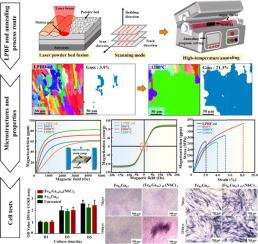当前位置:
X-MOL 学术
›
J. Adv. Res.
›
论文详情
Our official English website, www.x-mol.net, welcomes your feedback! (Note: you will need to create a separate account there.)
Synergistic effects of laser powder bed fusion and annealing on the texture-selective recrystallization of magnetostrictive Fe-Ga-NbC alloys for biomedical applications
Journal of Advanced Research ( IF 11.4 ) Pub Date : 2024-06-05 , DOI: 10.1016/j.jare.2024.06.007 Chengde Gao , Qi Zeng , Youwen Deng , Shuping Peng , Cijun Shuai
Journal of Advanced Research ( IF 11.4 ) Pub Date : 2024-06-05 , DOI: 10.1016/j.jare.2024.06.007 Chengde Gao , Qi Zeng , Youwen Deng , Shuping Peng , Cijun Shuai

|
Magnetostrictive Fe-Ga alloys have garnered extensive attention owing to their excellent magnetic properties and acceptable biocompatibility. Nevertheless, the polycrystalline Fe-Ga alloys currently available tend to display random texture orientations, which constrain their magnetostrictive performance. To regulate the texture orientation of Fe-Ga-NbC alloys and thereby enhancing magnetostriction. In this study, a processing route comprising laser powder bed fusion (LPBF) followed by secondary recrystallization annealing (800, 1000, and 1200 °C, respectively) was developed to prepare Fe-Ga-NbC alloys. The results showed that the LPBF-ed (FeGa)(NbC) alloys exhibited a high content of high energy grain boundaries (HEGBs) due to the repeated melting and solidification. In subsequent annealing process, the migration of HEGBs induced the rearrangement and recrystallization of grains, during which NbC was found to locate at the grain boundaries and influence the migration path of HEGBs via selective pinning, thereby resulting in a strong Goss texture. With the rise in annealing temperature, the content of Goss texture gradually increased from the initial 3.9 % to 71.3 % at 1200 °C, leading to enhanced magnetostriction, lower saturation magnetization and coercivity. Furthermore, in alternating magnetic fields, the alloys annealed at 1200 °C also exhibited higher magnetostriction than the LPBF-ed alloys. And a noteworthy grain coarsening was also observed after annealing, accompanied by a discernible inclination of magnetic domains towards strip domains. Additional, cell tests demonstrated that the prepared alloys had satisfactory biocompatibility and the ability to promote osteogenic differentiation. These findings indicated that the LPBF-ed and annealed Fe-Ga-NbC alloys might be a promising alternative as magnetostrictive-driven materials for biomedical applications.
中文翻译:

激光粉末床熔化和退火对生物医学应用磁致伸缩 Fe-Ga-NbC 合金织构选择性再结晶的协同效应
磁致伸缩铁镓合金因其优异的磁性能和良好的生物相容性而受到广泛关注。然而,目前可用的多晶铁镓合金往往表现出随机的织构取向,这限制了它们的磁致伸缩性能。调节 Fe-Ga-NbC 合金的织构取向,从而增强磁致伸缩。在这项研究中,开发了一种工艺路线,包括激光粉末床熔合 (LPBF),然后进行二次再结晶退火(分别为 800、1000 和 1200 °C)来制备 Fe-Ga-NbC 合金。结果表明,LPBF-ed (FeGa)(NbC) 合金由于反复熔化和凝固而表现出高含量的高能晶界 (HEGB)。在随后的退火过程中,HEGBs的迁移引起晶粒的重排和再结晶,在此过程中NbC被发现位于晶界并通过选择性钉扎影响HEGBs的迁移路径,从而产生强戈斯织构。随着退火温度的升高,戈斯织构的含量从最初的3.9%逐渐增加到1200℃时的71.3%,导致磁致伸缩增强,饱和磁化强度和矫顽力降低。此外,在交变磁场中,在 1200°C 退火的合金也表现出比 LPBF 合金更高的磁致伸缩。退火后还观察到显着的晶粒粗化,并伴随着明显的磁畴向条状磁畴的倾斜。此外,细胞测试表明所制备的合金具有令人满意的生物相容性和促进成骨分化的能力。 这些发现表明,LPBF 处理和退火 Fe-Ga-NbC 合金可能是生物医学应用中磁致伸缩驱动材料的有前途的替代品。
更新日期:2024-06-05
中文翻译:

激光粉末床熔化和退火对生物医学应用磁致伸缩 Fe-Ga-NbC 合金织构选择性再结晶的协同效应
磁致伸缩铁镓合金因其优异的磁性能和良好的生物相容性而受到广泛关注。然而,目前可用的多晶铁镓合金往往表现出随机的织构取向,这限制了它们的磁致伸缩性能。调节 Fe-Ga-NbC 合金的织构取向,从而增强磁致伸缩。在这项研究中,开发了一种工艺路线,包括激光粉末床熔合 (LPBF),然后进行二次再结晶退火(分别为 800、1000 和 1200 °C)来制备 Fe-Ga-NbC 合金。结果表明,LPBF-ed (FeGa)(NbC) 合金由于反复熔化和凝固而表现出高含量的高能晶界 (HEGB)。在随后的退火过程中,HEGBs的迁移引起晶粒的重排和再结晶,在此过程中NbC被发现位于晶界并通过选择性钉扎影响HEGBs的迁移路径,从而产生强戈斯织构。随着退火温度的升高,戈斯织构的含量从最初的3.9%逐渐增加到1200℃时的71.3%,导致磁致伸缩增强,饱和磁化强度和矫顽力降低。此外,在交变磁场中,在 1200°C 退火的合金也表现出比 LPBF 合金更高的磁致伸缩。退火后还观察到显着的晶粒粗化,并伴随着明显的磁畴向条状磁畴的倾斜。此外,细胞测试表明所制备的合金具有令人满意的生物相容性和促进成骨分化的能力。 这些发现表明,LPBF 处理和退火 Fe-Ga-NbC 合金可能是生物医学应用中磁致伸缩驱动材料的有前途的替代品。











































 京公网安备 11010802027423号
京公网安备 11010802027423号